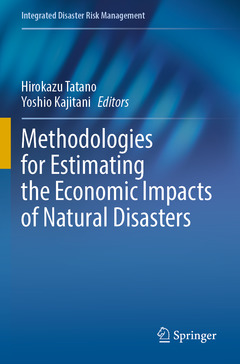Methodologies for Estimating the Economic Impacts of Natural Disasters, 1st ed. 2022 Integrated Disaster Risk Management Series

This book outlines methodologies to estimate the economic impacts of natural disasters based on business surveys conducted after large disasters in Japan. By including numerous observations on business activities in past disasters and the validations of both engineering and economic models based on these data sets, this book appeals to practitioners who estimate the regional economic impacts as well as to students and young professionals in various fields who conduct disaster impact studies. The book consists of 7 chapters and includes theories and practices, which help readers to interlink the estimation methods with real-world problems. The study primarily focuses on cases in Japan, but the methods employed can be generalized and applied in other countries.
Chapter 1
Introduction
1.1 History
1.2 Why do we need to quantify flow losses?
1.3 Approaches adopted in this booklet
Chapter 2
Functional fragility curves for production capacity
2.1 Introduction
2.2 Model and estimation procedures
2.2.1 Formulation of FFCs
2.2.2 Setting of damage states2.2.3 Formulation of likelihood function: multinominal response model
2.2.4 Confidence interval for FFC
2.3. Model estimation
2.3.1 Data
2.3.2 Estimation results
2.3.3 Estimation results for different industrial sectors
2.3.4 Confidence interval of FFCs
2.3.5 Expected capacity level
2.4 Summary
Chapter 3
Measures for Estimating Production Capacity Losses
3.1 Introduction
3.2 Lifeline resilience factor
3.3 Method to estimate production shocks
3.2.1 Earthquake disaster case
3.2.2 Flood disaster case
3.4 Application to earthquake and flood disasters
3.4.1 The Great East Japan Earthquake
3.4.2 Flood disaster case
3.4 Summary
3.5 References
Chapter 4
SCGE models to Assess Higher-order Impacts of Production Capacity Losses
4.1 Introduction
4.2 Literature Review
4.3 Basic Model and Key Parameters
4.4 Earthquake disasters
4.4.1 Data
4.4.2 How to reflect the PCLR into an SCGE model
4.4.3 Estimation Results
4.5 Flood disasters
4.6.Summary
Chapter 5
Economic Impacts of a Nankai Megathrust Earthquake Scenario
5.1 Introduction
5.2 Hazard Information
5.3 Estimated Economic Impacts of a Nankai Trough Earthquake Scenario
5.4 Summary
Chapter 6
Economic Impacts of the Transportation Network Disruption: An Extension of the SCGE Model
6.1 Introduction
6.2 The framework for economic loss estimation due to transportation network damages
6.3 The SCGE model to assess the interregional spillovers of direct damage through transportation networks
6.4 The Niigata-Chuetsu Earthquake—A Case Study
6.4.1 An overview of the disaster and model parameter settings
6.5 Conclusions
Chapter 7
ConclusionsDr. Hirokazu Tatano is a professor at the Disaster Prevention Research Institute, Kyoto University, Japan. Since September 2010, he has served as a vice president of the International Society of Integrated Disaster Risk Management (IDRiM). He is also currently the secretary-general of the Global Alliance of Disaster Research Institutes, which was established at the Second Global Summit of Research Institutes for Disaster Risk Reduction, March 19–20, 2015. He received his M.Sc. and Ph.D. in Civil Engineering from Kyoto University. Much of Dr. Tatano's research is on the economics of natural hazards. He led the socioeconomic assessment survey team of the Japan Society of Civil Engineering for the Great East Japan Earthquake in 2011. He also served as a leader of the disaster risk management research field of the Global Center of Excellence (GCOE) Program on Human Security Engineering for Asian Megacities and headed the Mumbai Base, which conducted a research program to implement community-led disaster risk reduction activities. He served as the principal investigator of a research project on disaster risk management strategy of global critical infrastructure, funded by a Ministry of Education, Culture, Sports, Science and Technology, Japan (MEXT) grant-in-aid. Dr. Tatano has done pioneering research on economic consequence analysis. Another major focus of his research has been on resilience to natural disasters at the levels of the individual business, market, and regional economies.
Yoshio Kajitani is a professor in Kagawa University, Japan. He received his Ph.D. in Civil Engineering from Kyoto University in 2004. His thesis was entitled Spatial-Temporal Exposure Assessment and Loss Estimation During Disasters. Previously, Dr. Kajitani had received a bachelor’s degree in civil engineering from Kyoto University in 1997 and a master’s degree in statistics from the University of Western Ontario (now Western University) in 1999. His studi
Provides step-by-step tutorials with each chapter explaining each step
Presents theories and practices in each chapter
Compares cutting-edge approaches and well-known ones
Date de parution : 10-2022
Ouvrage de 99 p.
15.5x23.5 cm
Date de parution : 10-2021
Ouvrage de 99 p.
15.5x23.5 cm
Disponible chez l'éditeur (délai d'approvisionnement : 15 jours).
Prix indicatif 137,14 €
Ajouter au panier


